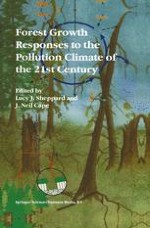1999 | OriginalPaper | Chapter
Foliar Symptoms and Growth Reduction of Ailanthus altissima Desf. in an Area with High Ozone and Acidic Deposition in Italy
Authors : E. Gravano, M. Ferretti, F. Bussotti, P. Grossoni
Published in: Forest Growth Responses to the Pollution Climate of the 21st Century
Publisher: Springer Netherlands
Included in: Professional Book Archive
Activate our intelligent search to find suitable subject content or patents.
Select sections of text to find matching patents with Artificial Intelligence. powered by
Select sections of text to find additional relevant content using AI-assisted search. powered by
Since 1985, severe defoliation and foliar symptoms have been observed on Ailanthus altissima Desf. ratmets located at a site where high ozone concentration (up to 128 n1·1−1), strongly acidic drizzle and dew (to pH 1.4) were recorded. The behaviour of plants growing in an open field (directly exposed to the pollutants), and below the canopy of an old stone pine stand was compared. Compared to the below-canopy trees, the open field trees show a variety of foliar symptoms (diffuse yellowing, apical, marginal and spot-like necrosis and interveinal bronzing and stippling), defoliation and much less vegetative vigour. Experimental treatments with acidic mist caused the same necrosis observed in the field, but failed to reproduce bronzing and stippling. Since then, stipple and bronzing have been observed again at a variety of locations in the same area as well as throughout Italy, while necrosis has only seldom been recorded. Recently, surveys on symptoms have been supported by anatomical analysis by mean of light microscope and by experiments in fumigation chambers. On the whole, the results led us to suspect ozone sensitivity. These findings suggest that the symptoms observed since 1985 in the surveyed area were probably caused by the combined effects of both strongly acidic episodes and exposure to high ozone levels.
